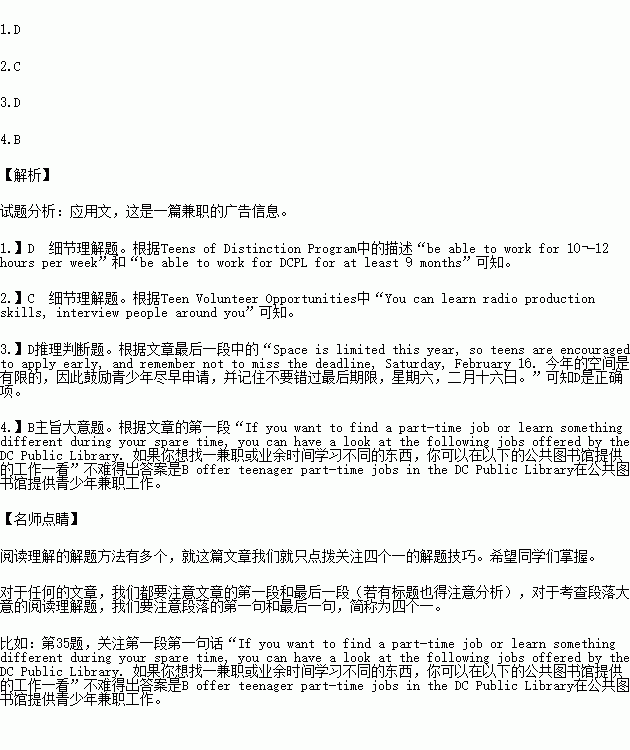题目内容
If you want to find a part-time job or learn something different during your spare time, you can have a look at the following jobs offered by the DC Public Library.
Teens of Distinction Program
The DC Public Library offers part-time jobs for teens through the Teens of Distinction Program. Teens work for 10-12 hours per week all year long, helping the library with important tasks and projects. The Teens of Distinction Program is now hiring! To apply, you have to:
● be a DC resident
● have and maintain at least a 2.5 grade point average
● be 16 to 18 years old
● be able to work for 10-12 hours per week
● be able to work for DCPL for at least 9 months
Oh, and of course you have to impress us with your wonderful personality!
Teen Volunteer Opportunities
If you want to earn community service hours for school, Youth 202 is a good choice.
Youth 202 is a radio program created by youth and for youth. You can learn radio production skills, interview people around you, and help keep other teens to learn news, events, and anything else you think is important.
Summer Youth Employment Program (SYEP)
Every summer, teens can work here to help library customers organize books and learn lots of new skills, such as program planning, writing and media production.
On Friday, January 25 at 12:15 p.m., the application for the 2014 SYEP will be open to teens between the ages of 14 and 21.
Applications will be processed on a “first-come, first-served” basis. Space is limited this year, so teens are encouraged to apply early, and remember not to miss the deadline, Saturday, February 16.
1.Working for the Teens of Distinction Program, teenagers will ________.
① become a DC resident
② work for 10-12 hours per week
③ work for DCPL for at least 9 months
④ have a wonderful personality
A. ③④ B. ①②③ C. ①③④ D. ②③
2.If a teenager wants to interview people around him, he should apply for a job at ________.
A. Teens of Distinction Program
B. Teens Library
C. Youth 202
D. Summer Youth Employment Program
3.Who has the biggest chance to work for the 2014 SYEP?
A. A teenager who is smart.
B. A teenager who is popular.
C. A teenager who gets high grades in exams.
D. A teenager who applies early.
4.The aim of the text is to ________.
A. introduce the DC Public Library
B. offer teenager part-time jobs in the DC Public Library
C. teach how to apply for part-time jobs
D. describe the job of library workers
All bookings made before 12 September will receive free travel insurance for
the entire family! ** Insurance is issued by Live Life Insurance Group.

10% OFF ALL BOOKINGS
for departures from 5 to 11 September
* Child must be accompanied by two paying adults.
** Terms and conditions apply.
1.One of the benefits mentioned in, the advertisement is .
A. a free flight to any destination in the world
B. 30% off any book purchased at Ruby Bookstore
C. a discount on any course at Tanya Language School
D. a free bowl of dessert at any restaurant at the airport
2.Which of the following bookings may receive the most benefits?
A.
Booking date | Departure date |
September 13 | September 18 |
B.
Booking date | Departure date |
August 15 | September 4 |
C.
Booking date | Departure date |
September 2 | September 12 |
D.
Booking date | Departure date |
August 16 | September 8 |
3.Which of the following is TRUE according to the advertisement?
A. Club members enjoy free travel insurance for any flight.
B. You need to pay $50 to sign up a child under the age of 12 for the club.
C. The advertisement is intended for students of all ages.
D. Any child must be accompanied by at least one paying adult.
4.Where is the passage probably taken from _____________?
A. A magazine. B.A newspaper.
C. A report. D. A website.

